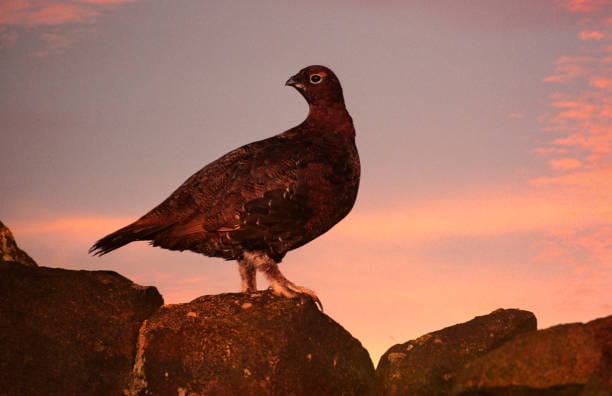All about Birds
Alaska’s State Bird – Get To Know Willow Ptarmigan
Alaska is home to many amazing animals, but one of our favorites is the Willow Ptarmigan. This bird is not only beautiful but also unique in many ways. For starters, the Willow Ptarmigan is the only member of the grouse family that can be found in Alaska all year round.
Not only is the Willow Ptarmigan Alaska’s state bird, but it is also the official bird of the Yukon Territory in Canada. This little bird is well-adapted to life in the cold and can be found in tundra, muskeg, and forest habitats across Alaska.
If you’re ever in Alaska, keep your eyes peeled for the Willow Ptarmigan. This little bird is truly a sight to see!
Willow Ptarmigan Facts

The Willow Ptarmigan is a small bird, measuring about 16 inches long. The males are slightly larger than the females and have a wingspan of about 24 inches. These birds are mostly brown with white feathers on their belly and tail.
Both male and female Willow Ptarmigans have white feathers on their legs and feet. This helps to camouflage the bird in the snow and makes it harder for predators to spot them.
The Willow Ptarmigan is a ground-dwelling bird and does not build nests. Instead, the female will lay her eggs on the ground in a hidden location. She will then use her body to keep the eggs warm until they hatch.
During the summer months, the Willow Ptarmigan’s feathers turn a red-brown color. They can be found in open areas near willow trees. In the winter, it moves to more forested areas. The willow ptarmigan is a ground-dwelling bird and makes its nest on the ground.
Why is the Willow Ptarmigan the State Bird for Alaska?

There are many reasons why the Willow Ptarmigan was chosen as Alaska’s state bird. The first reason is that the bird is very common in Alaska. The second reason is that the bird is a good representation of Alaska’s wildlife. The third reason is that the bird is a symbol of peace and unity.
When did the Willow Ptarmigan become the state bird for Alaska?

The Willow Ptarmigan became Alaska’s state bird on May 6, 1955. The decision was made by the Alaska Legislature after a fourth-grade class from Fairbanks petitioned for the change. The Willow Ptarmigan was chosen because it is the only bird that is found in all parts of Alaska and it is well-adapted to life in the state’s harsh climate.
What Do Willow Ptarmigan Eat?

These birds are omnivores and their diet consists of mostly plants and insects. In the summer months, they will eat berries, leaves, and seeds. During the winter, when food is scarce, they will eat buds and twigs.
The Willow Ptarmigan is an important part of the Alaskan ecosystem. They help to disperse seeds and control insect populations. These birds are also popular with hunters and are considered good table fare.
Can The Willow Ptarmigan Fly?

This is a question that many people ask about the willow ptarmigan, Alaska’s state bird. The answer is yes, the willow ptarmigan can fly, but it doesn’t do so very often. Instead, this bird prefers to walk or run.
Where Are Willow Ptarmigan Found?

Willow ptarmigan are found in the northern hemisphere in countries like Canada, Greenland, Iceland, Scandinavia, Russia, and the United States. In North America, they breed in Alaska and parts of northern Canada. They winter in southern Alaska and central British Columbia south to Colorado and New Mexico. A few may even be found in Washington, Idaho, and Montana.
Willow ptarmigan are also found in Eurasia. Their breeding range extends from Iceland and Scandinavia to Russia, China, North Korea, and southern Siberia. They winter in southern Europe and Asia south to the Himalayas. In some areas of their range, willow ptarmigan are year-round residents.
Is The Willow Ptarmigan Endangered?

No, the willow ptarmigan is not endangered. It is doing quite well in its native habitat of Alaska. The bird’s main predators are humans and other animals such as foxes, weasels, and coyotes. However, the willow ptarmigan has a few things working in its favor. First, it is very good at hiding in its environment. Second, the bird has a strong sense of self-preservation and will not hesitate to attack if it feels threatened. Finally, the willow ptarmigan is an excellent flyer and can escape from predators quickly.
What Do Ptarmigans Sound Like?

Ptarmigans are relatively silent birds. The males will make a “tee-tee-tee” sound during the breeding season to attract females, but other than that they don’t make much noise. Their calls are so quiet that you might not even realize there’s a ptarmigan nearby unless you see it.
Rock Ptarmigan Vs. Willow Ptarmigan

Confused about the difference between a rock ptarmigan and a willow ptarmigan? You’re not alone. Even experts have a hard time telling them apart. Here are a few key differences:
1. Rock ptarmigans are generally larger than willow ptarmigans.
2. Rock ptarmigans have darker plumage.
3. Willow ptarmigans have a white stripe above their eyes, while rock ptarmigans do not.
4. Rock ptarmigans are found in mountainous regions, while willow ptarmigans are found in tundra and forested areas.
5. The diet of a willow ptarmigan consists mostly of willow leaves, while the diet of a rock ptarmigan consists mostly of mosses and lichens.
Now that you know the difference, can you tell which is which? If not, don’t worry – even experts have a hard time telling them apart!
Final Thoughts
The willow ptarmigan, Alaska’s state bird, is a fascinating creature. It is well-adapted to life in the harsh Arctic environment and has many unique characteristics that make it a true Alaskan icon. If you ever have the opportunity to see one in person, be sure to take the time to appreciate this amazing bird.

